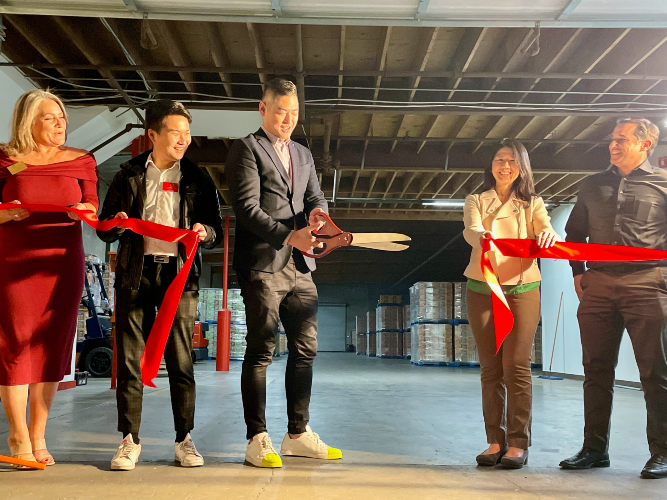
Chang, however, was not ready to give up his job at Warner Bros. Entertainment Inc. in Burbank until they had the proof of concept. He continued with his corporate gig for another three years, helping market A-Sha Foods out of his Pasadena home in his spare time while Liao oversaw production in Taiwan.
“I think the first large grocery chain that we got into was Safeway/Albertsons in 2015, and after that, we decided, ‘Okay, this is now a viable business, we should really incorporate it and set it up properly,’” said Chang, who serves as the company’s chief executive.
Since then, A-Sha Foods has been on an upward trajectory. It generated $23 million in revenue last year, up from $6 million in 2019, and is on track to end 2021 with $25.3 million in sales. The noodle company has 12 employees and operates a 50,000-square-foot warehouse in Alhambra.
Chang said the company’s growth in the early days hinged on the Taiwanese diaspora, which already had developed a preference for A-Sha’s air-dried noodles and considered them a healthier alternative to the fried instant noodles Momofuku Ando invented in 1958.
“We spread the word online, through Chinese media, and we sold on Amazon, and we would put our products at Taiwanese restaurants and coffee shops — that was our core,” he said, adding that as the demand grew, the company pivoted to “doing more international PR and marketing, and we ended up changing our packaging to fully English, and that kind of assimilated our product more into the American mainstream.”
The move helped A-Sha reach a wider fanbase and by 2015 get into Albertsons Cos. Inc. stores. The company had three employees at the time, including Chang, along with strong financial backing from his brother-in-law’s Breeze Group, an owner of several prominent shopping centers in Taiwan. The next big win was shelf space in Kroger Co.’s 1,800 stores in 2016, followed by distribution deals with Walmart Inc., Target Corp. and Costco Wholesale Corp.
“When you land these big accounts, you actually have to have a lot of capital to produce enough product to get it on the shelf,” Chang said. “For us, having that extra capital allowed us to be able to expand fast enough so that we could go for these big, big businesses. A lot of times, small companies may have a hit product, but if you don’t have the ability to produce for Walmart or Target, then your product pretty much is just stuck in that startup phase.”
A-Sha Foods, in addition to retail, started collaborating with MomoIP, doing business as Momofuku, a New York-based restaurant chain.
“They … chose us to be their exclusive noodles supplier, so anything that’s packaged from Momofuku will be developed by A-Sha,” Chang said. “The product itself launched only in October of this year, exclusively in Target stores nationally.”
He added that A-Sha Foods also has a strategic partnership with Sanrio Co. Ltd., which included Hello Kitty noodles created for the Tokyo Olympics.
“That was such a huge success that we have a ‘round two’ program that’s developing right now, and it’s going to be coming out in February,” he said.
Bringing A-Sha ramen noodles to restaurants is next on Chang’s list.
“Right now, we’re primarily on the retail side, and the foodservice side is a whole other revenue generator that we have not even begun to explore yet because our focus strategically has been to establish the brand,” he said. “But the foodservice thing, that could actually even be bigger than our retail operation because the type of noodle that we make is so flexible in that space. So, that’s something that we’re looking at heavily right now.”
